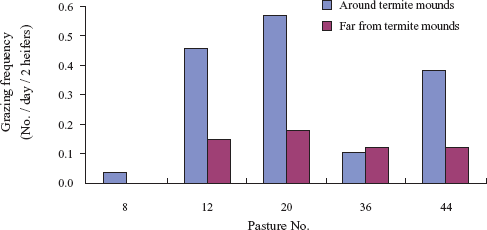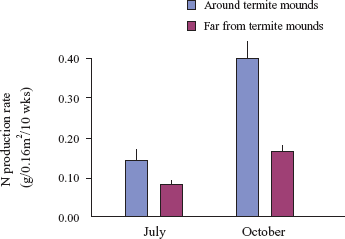Termite activities increase the productivity and nutrient value of grasses and grazing frequency by cattle around termitarias
Description
[Objectives]
Termites play leading roles in organic matter decomposition and nutrient cycling in tropical and subtropical zones. It is important, therefore, to understand the effects of termite activity on soil fertility, grass growth and cattle grazing in subtropical pastures, in order to predict the dynamics of agropastral systems and to enhance their productivity and sustainability. Soil fertility, productivity and nutrient value of grass, Brachiaria decumbens, as well as the grazing behavior of cattle in areas near termite mounds populated by the species Cornitermes cumulans were compared with those of control areas free of mounds in subtropical pastures of Brazil.
[Results]
The total carbon and nitrogen content of the surrounding soil increased as the distance to the mounds decreased in the lower soil layers, whereas a clear pattern could not be deduced for upper soil layers. The rates of height elongation, dry matter production and crude protein production of grass per unit area were approximately 1.4, 1.6 and 2.1 times higher, respectively, around termite mounds than those of control areas (Fig.1). It was observed, using cameras with infrared ray sensors, that cattle grazed in these nutritious and productive grasses around the mounds with much higher frequency than in control areas (Fig. 2). As a result, the height of the grass always remained lower within a 68 cm radius, on average, of the margins of termite mounds.
In areas surroundings termite mounds, increases in productivity and nutrient value of grasses due to soil nutrient enrichment is expected to induce the frequent and preferential grazing of cattle. This suggests that the presence of termite mounds exerts significant influence on the grazing behavior and intake of nutrition, especially crude protein, of cattle and therefore affects beef quality of cattle raised in subtropical pastures. It is crucial for this to be taken into consideration when managing subtropical pastures in which C4 grasses with low crude protein content are predominant and where supplying legumes as major nitrogen sources for cattle is often difficult.
Figure, table
-
Fig. 1. Grazing frequency of two heifers per day. -
Fig. 2. Nitrogen production rate (N g/0.16 m2/10 wks) near and for from termite mounds in Brachialia decumbens pasture.
Vertical bars indicate + 1 SE for 12 repetitions.
- Affiliation
-
Japan International Research Center for Agricultural Sciences Animal Production and Grassland Division
- Classification
-
Technical A
- Term of research
-
FY2002 (FY2001-2002)
- Responsible researcher
-
FUKUDA Eiki ( Animal Production and Grassland Division )
- ほか
- Publication, etc.
-
Fukuda, E., Macedo, M.C.M., Borges, M.J. and Pitaluga, G.M. (2003): Effects of mounds of a termite Cornitermes cumulans on grass production and behavior of grazing cattle in semitropical grasslands in Brazil. Grassland Science 49, 24-25.
- Japanese PDF
-
2003_16_A3_ja.pdf2.28 MB
- English PDF
-
2003_16_A4_en.pdf48.97 KB


